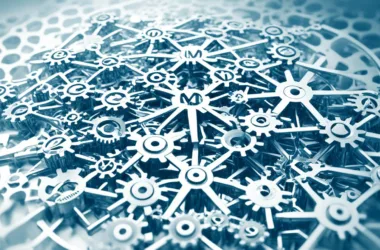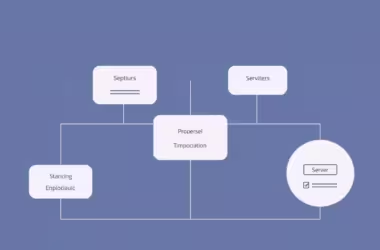Having good monitoring and logging strategies is key for software architecture’s health. They help find and fix issues, keeping the system’s performance and reliability up. With today’s complex software, like microservices and distributed systems, strong strategies are a must. They make analyzing systems, finding errors, and boosting performance easier. This ensures businesses can count on their software to work smoothly and efficiently.
Key Takeaways
- Monitoring and logging are crucial for maintaining software performance and reliability.
- Effective strategies assist in detecting issues, troubleshooting, and improving system quality.
- Modern software, including microservices and distributed systems, requires robust monitoring and logging systems.
- Implementing these strategies aids in system analysis, error tracking, and performance optimization.
- Reliable monitoring ensures that businesses can depend on their software for efficient operations.
Introduction to Monitoring and Logging in Software Architecture
Monitoring and logging are key to keeping software running smoothly. They are especially important in complex setups like distributed systems. By recording essential data, these processes help fix problems fast, keeping everything working well.
Why Monitoring and Logging are Critical
Monitoring and logging give insights into how well applications are doing. They help find and fix problems quickly. In distributed systems, they are crucial for finding why things go wrong.
Overview of Modern Software Architectures
Today’s software architectures use advanced methods, such as microservices. These methods split apps into smaller services that work together. Though this makes managing the system more complex, monitoring and logging keep things running smoothly.
This approach helps in many ways. It makes the system more efficient and secure. It also ensures every part works well together and uses resources wisely.
Key Elements of Effective Monitoring
Effective monitoring keeps software systems running smoothly. It includes key parts that ensure the system stays healthy. These parts quickly tackle any problems that come up.
Application Performance Monitoring
Application Performance Monitoring (APM) measures and manages app performance. It makes sure apps are fast and responsive. By spotting and fixing problems fast, APM keeps users happy.
Infrastructure Monitoring
Infrastructure monitoring is vital for system support. It keeps an eye on hardware and software like servers and databases. This ensures everything works well together, preventing downtime.
Distributed Tracing
Distributed tracing tracks requests across services in microservices setups. It’s key for seeing a request’s path and fixing slowdowns. This gives a clear picture of service interactions, easing problem-solving.
These monitoring elements are crucial. They keep software efficient and reliable. With these methods, businesses can maintain smooth software operations.
Best Practices for Logging in Microservices Architecture
Implementing effective logging is key in microservices. It’s important to follow best practices. This makes sure logs are consistent and useful for debugging.
Standardize Your Logs
One top practice is to standardize logs. Using a common log format like JSON helps a lot. It makes logs easy to read and look through. This is crucial for handling large data amounts in microservices.
Centralize Your Logs in a Log Management System
It’s also critical to manage logs centrally. This means putting all logs in one place with tools like log collectors. Doing this helps fix problems faster by giving a clear view of all logs.
A central log system makes using logs easier. It also boosts security and helps manage storage and compliance better.
Correlate Your Logs
Log correlation is vital for tracking user requests across services. Using unique identifiers, like correlation IDs, is essential. It lets you see a request’s path through different services.
By connecting logs, crafting a clear picture of each user interaction becomes easier. This improves the ability to find and fix problems, making your microservices architecture more transparent.
Monitoring and Logging Strategies for Software Architecture
Having good monitoring and logging strategies is key for top software performance. These methods are based on set practices, smart tools, and careful choices. They keep things running smoothly and reliably.
Using strategic logging techniques helps keep a close watch on how things are doing. It lets teams track performance in real-time and study log data. By focusing on finding and fixing mistakes quickly, software works better. Plus, these methods can stop problems before they start, keeping services steady.
To make software perform its best, adding detailed logging is a must. This way, spotting and heading off trouble becomes easier. It also leads to taking action early, which keeps the software strong and working well.
In summary, good monitoring and logging are vital for checking software and keeping it running well. If these strategies are used right, they make software systems more reliable and effective.
Advanced Log Analysis and Management Techniques
Effective log management is key to keeping systems running smoothly. By analyzing logs, we can catch issues early on. Techniques include putting logs together, using tools to visualize them, and tracking how the system performs.
Aggregating and Querying Logs
Bringing logs together from different places helps a lot. It makes it easier to look through them. This way, teams can spot problems or security risks fast.
Log Visualization Tools
Visual tools are great for understanding log data. They turn complex logs into easy-to-read visuals. This not only helps with looking at past performance but also predicts what might happen next.
Performance Metrics Logging
It’s important to keep track of how your system is doing. By logging key performance metrics, you can catch issues before they become big problems. This step keeps systems reliable and avoids downtime.
Using analytics and visual tools for logs is crucial. It helps teams keep systems running at their best. By focusing on these techniques, problems can be solved quickly, and systems can keep improving.
Error Tracking and Incident Management
Keeping a software system reliable is a must. Error tracking and incident management help fix failures fast. This minimizes disruption. Automating alerts is a critical move.
Handling Failures Efficiently
It’s vital to notice problems quickly. This stops them from getting worse. Error tracking lets you spot and fix errors right away. This way, your system stays up and runs smoothly.
Automated Alerting Systems
Automated alerts are key for managing incidents. They notify teams immediately, ensuring a quick reaction. This makes error tracking more efficient and reduces mistakes.
Incident Response Strategies
Incident response strategies are core to efficient problem solving. They guide how to react once an alert comes. These plans limit damage and restore the system quickly.
Ensuring Security and Compliance in Logging
Ensuring logging security means keeping sensitive data safe and following regulations. We must be careful to avoid logging sensitive info. At the same time, we must use strong security steps and keep up with audits.
Avoid Logging Sensitive Data
It’s crucial not to log sensitive info, like social security numbers, homes, and money details. By hiding or leaving out this kind of data, companies can avoid data leaks. They can also follow data protection laws.
Implementing Security Measures
Keeping log data safe is key. Encrypt logs when storing or sending them to keep them away from the wrong hands. Only let certain people access these logs. This makes your security better.
Auditing and Compliance Logs
Audits and keeping proper logs are a must to meet regulations. These logs track who accessed and changed data. By auditing how we log, companies can find weak spots. They also show they are following the rules, which is important for keeping data safe and secure.
Leveraging Observability for Better Monitoring
Observability helps improve understanding and enhances performance insights. It plays a vital role in modern monitoring systems.
Understanding Observability
Unlike traditional monitoring that focuses on specific metrics, observability goes deeper. It lets teams grasp the inner workings of systems through external outputs. This offers a fuller view of system health and performance.
Logs, Metrics, and Traces as Pillars of Observability
Observability relies on logs, metrics, and traces. Logs record detailed event data, metrics quantify aspects, and traces follow request paths. Together, they give a full view of how a system operates.
Combining Logs and Traces for Deep Insights
Combining logs and traces is key for deep telemetry analysis. This combination reveals detailed insights about system performance and issues. It leads to quicker problem solving and enhances system reliability.
Role of DevOps in Monitoring and Logging
DevOps is key in modern software building. It brings new monitoring and logging methods. This helps software improve constantly and fixes problems fast.
DevOps Monitoring Tools
DevOps teams use many tools for monitoring and logging. For example, Prometheus tracks performance, Grafana creates visual dashboards, and ELK Stack manages logs. These tools help understand how well systems are performing.
Continuous Monitoring and Feedback Loops
DevOps focuses on always watching and getting feedback to keep systems healthy. Teams quickly find and solve problems, cutting down on downtime. Ongoing feedback makes the software better.
Integration with CI/CD Pipelines
It’s important to include monitoring and logging in CI/CD pipelines. This checks new code for issues automatically. It helps make deployment smooth and safe.
Popular Tools and Technologies for Monitoring and Logging
Today, lots of tools help manage monitoring and logging. People often choose OpenTelemetry, the Elastic Stack (ELK), and Prometheus and Grafana. Each tool has special features that help us understand and control systems better.
OpenTelemetry
OpenTelemetry is great because it follows a standard method for telemetry data. It deals with metrics, traces, and logs. This makes it easy to add to applications. It works well with many systems, which is great for developers wanting solid monitoring.
Elastic Stack (ELK)
ELK stands for Elasticsearch, Logstash, and Kibana. It’s really good for analyzing and visualizing logs. Elasticsearch searches data well. Logstash processes log data and Kibana makes dashboards. This makes ELK perfect for managing logs.
Prometheus and Grafana
Prometheus and Grafana are known for their monitoring and analytics. Prometheus is good at collecting time-series data. It can also send alerts. Grafana shows this data in detailed dashboards. This lets teams see how well systems are performing. Together, they improve monitoring and data analysis.
Conclusion
Effective monitoring and logging are key for making software better. They help manage systems before issues get big. Today’s software, with all its parts and services, needs a smart way to keep an eye on things. By organizing logs well and using top tools, teams can get a full view of their systems.
Keeping things secure and following rules are big parts of logging. It’s important to avoid logging private info. Strong security steps can stop unwanted access and meet rules. With good error tracking and handling, services keep running smoothly.
DevOps makes these strategies even better. It does this by always monitoring, giving feedback, and fitting into CI/CD workflows. Using tools like OpenTelemetry, Elastic Stack (ELK), and Prometheus with Grafana offers deep insights. The goal is to quickly make sense of system actions. This keeps software delivery competitive.






